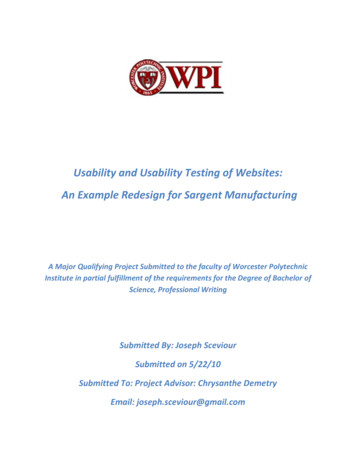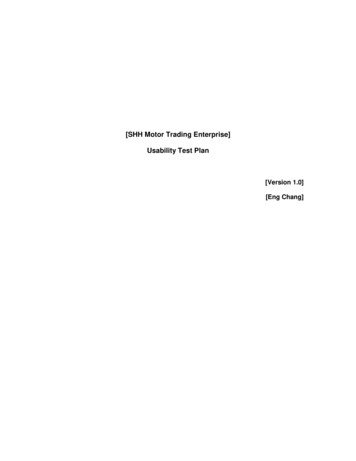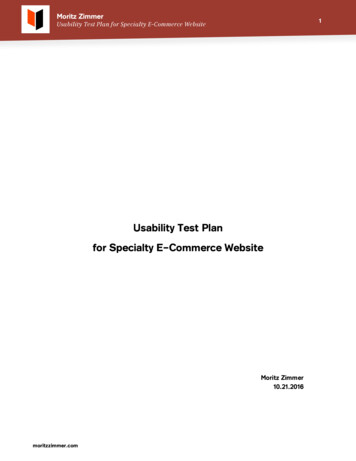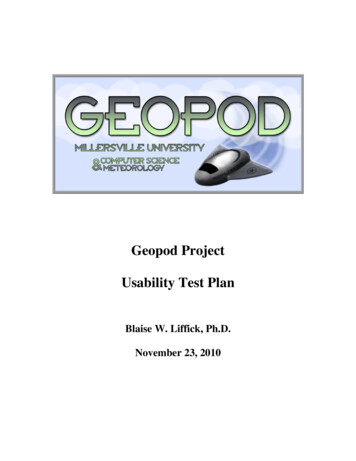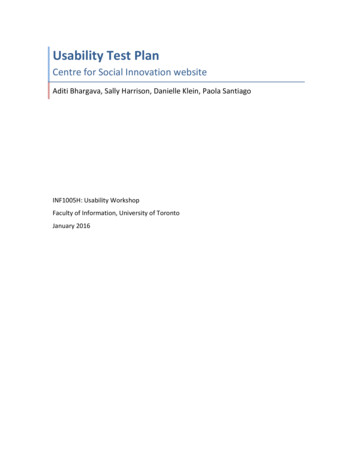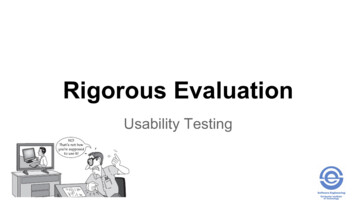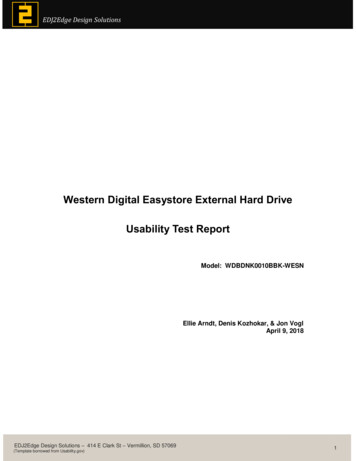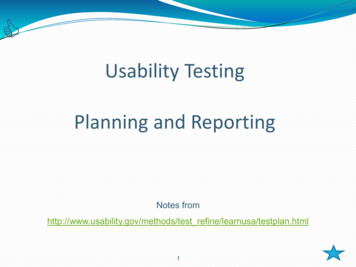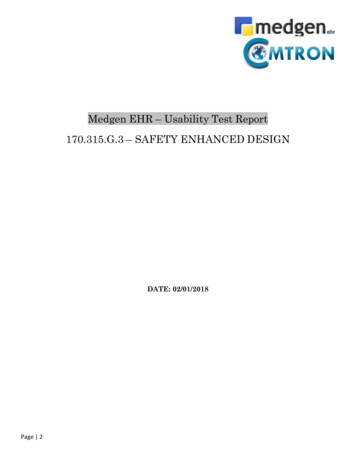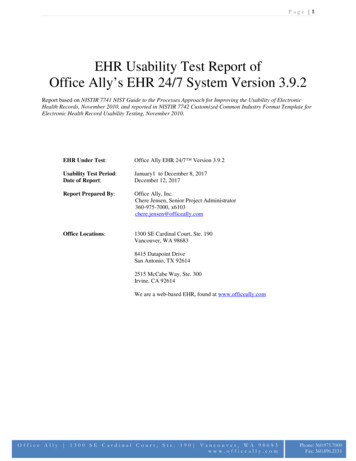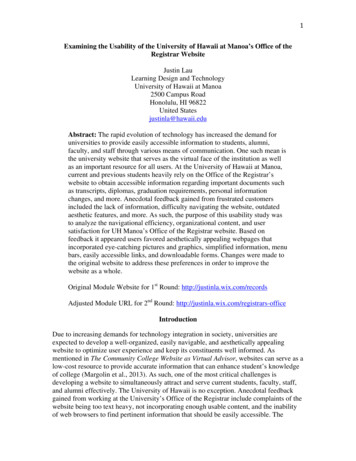
Transcription
1Examining the Usability of the University of Hawaii at Manoa’s Office of theRegistrar WebsiteJustin LauLearning Design and TechnologyUniversity of Hawaii at Manoa2500 Campus RoadHonolulu, HI 96822United Statesjustinla@hawaii.eduAbstract: The rapid evolution of technology has increased the demand foruniversities to provide easily accessible information to students, alumni,faculty, and staff through various means of communication. One such mean isthe university website that serves as the virtual face of the institution as wellas an important resource for all users. At the University of Hawaii at Manoa,current and previous students heavily rely on the Office of the Registrar’swebsite to obtain accessible information regarding important documents suchas transcripts, diplomas, graduation requirements, personal informationchanges, and more. Anecdotal feedback gained from frustrated customersincluded the lack of information, difficulty navigating the website, outdatedaesthetic features, and more. As such, the purpose of this usability study wasto analyze the navigational efficiency, organizational content, and usersatisfaction for UH Manoa’s Office of the Registrar website. Based onfeedback it appeared users favored aesthetically appealing webpages thatincorporated eye-catching pictures and graphics, simplified information, menubars, easily accessible links, and downloadable forms. Changes were made tothe original website to address these preferences in order to improve thewebsite as a whole.Original Module Website for 1st Round: http://justinla.wix.com/recordsAdjusted Module URL for 2nd Round: ionDue to increasing demands for technology integration in society, universities areexpected to develop a well-organized, easily navigable, and aesthetically appealingwebsite to optimize user experience and keep its constituents well informed. Asmentioned in The Community College Website as Virtual Advisor, websites can serve as alow-cost resource to provide accurate information that can enhance student’s knowledgeof college (Margolin et al., 2013). As such, one of the most critical challenges isdeveloping a website to simultaneously attract and serve current students, faculty, staff,and alumni effectively. The University of Hawaii is no exception. Anecdotal feedbackgained from working at the University’s Office of the Registrar include complaints of thewebsite being too text heavy, not incorporating enough usable content, and the inabilityof web browsers to find pertinent information that should be easily accessible. The
2development of a successful university website must take into consideration the needs ofthe users and the information they seek rather than solely rely on the developer’sperspective. Doing so will help simplify websites by incorporating only necessaryinformation that users will need, thus increasing user satisfaction (Bringula & Basa,2011). In addition, there are other motivational factors that have shown to influence one’sacceptance of a website to increase user satisfaction. These factors, specified by theUnited Theory of Acceptance and Use of Technology, include performance and effortexpectancy, social influence, behavioral intention, facilitating conditions, and userbehavior. As such, web developers in higher education benefit by studying their targetaudience to incorporate components into the website that relate to users, thus increasingperformance and effort expectancy as well as social influence (Van Schaik, 2009). Theseefforts made by developers will subsequently improve user experience as a whole.To eliminate frustration it is also critical for universities to grow with currenttechnological trends by providing an aesthetically pleasing, well organized, and easy tonavigate website. The purpose of this usability study was to analyze navigationalefficiency, organization of content, and user satisfaction for the University of Hawaii atManoa’s Office of the Registrar website that provides information and services (focusingon transcripts, diplomas, enrollment, and student data updates) for current and previousstudents.Working at the Office of the Registrar has exposed me to the frustration expressed bycurrent and former students in regards to the Office of the Registrar’s website. Fromconversations with unsatisfied individuals, I have realized that many of their needs couldhave easily been met by adding necessary information and forms accessible on thewebsite, creating a more user-friendly layout to increase satisfaction, and minimizingjargon to foster better navigation. These experiences sparked my interest to develop asolution to the office’s confusing website. Designing a more effective website will easethe irritation of current users and in turn decrease the volume of unnecessary phone callsfor staff members of the Office of the Registrar. On a daily basis, many staff membersspend a substantial amount of their time providing guidance on issues which are currentlyaddressed on the website. This usability study has allowed me to gain insight into thespecific needs of users through a series of surveys, recorded scenario questions, andobservations. The data gathered and analyzed throughout this study pinpointed majorneeds of current users along with defined specific problems of the Office of theRegistrar’s website. The redesign of this website addressed these issues and provided amore user-friendly interface.Background and Literature ReviewUsability is defined as the capability of a technology to be easily and effectively used byusers to perform a wide range of tasks for specific purposes (Mentes & Turan, 2012).When conducting a usability study, individuals are observed as they navigate through aparticular website to determine the functionality and navigational ease of the interface.After all, the primary function of websites is to provide users with the necessary
3information they require to achieve specific goals with effectiveness, efficiency, andsatisfaction (Kincl & Strach, 2012).When conducting a usability study to improve websites, there are several importantcomponents to consider in terms of content, design, and navigation of the interface.Content should be clear, concise, and written in appropriate language for all users tounderstand. To generate interest, web design should be kept consistent and the interfaceshould be formatted such that navigation is simple, intuitive, and minimizes the need foradditional searches and scrolling (Nikolova-Houston, 2005). Although not all ideas willbe successful at first try, it is important to know that usability studies are works inprogress that require multiple tests to reach the desired results (Reynolds, 2008).Through first-hand interactions, users of the current Office of the Registrar websitesuggested that the redesign of the website is critical in resolving issues of unusablecontent, lack of navigational efficiency, and the need for more usable links andinformation. Websites are great resources to allow users to access information at thetouch of their fingertips. As such, it is crucial to ensure that web links to importantmaterials or forms are available and easy to find (McMillen & Pehrsson, 2009). Inaddition to creating easy navigational links, the new website attempted to resolve theseissues by simplifying the organization of content on various student services web pages,adding additional eye appealing graphics/pictures, incorporating necessary informationfor users, and eliminating unnecessary text heavy content. In the study titled Study of theUsability of University Registrar’s Office Website, it was determined that minor changesin redesigning drop down menus and web banners increased user experienceexponentially (Tuzun et al., 2013). This is especially true for a university website that isso frequently used by students in higher education such as the Registrar’s Office website.Visual design components of a website are significant to consider when designing a userfriendly, eye appealing, and successful web interface. Studies have shown that elementsof background contrast, screen layout, color palette, and grouped items all can have apositive effect on usability (Foley, 2011). Additional elements such as pictures andgraphics can also influence a product’s appearance. Aesthetically appealing productshave proven to spark intrigue and curiosity amongst users, thus increasing usermotivation and performance when using the product (Sauer & Sonderegger, 2011).However, the emphasis should not be placed solely on the aesthetic features of a website,as excessive or inappropriate graphic designs may become distracting for users (Loh &Williams, 2002). Rather, the combination of content, presentation, and overallimpression of a website will play an integral role in user satisfaction (Kincl & Strach,2012).Another factor that should be considered when updating the Registrar’s Office website isits compatibility with devices such as smartphones, tablets, PDAs, and other portabledevices that have the ability to connect to the Internet. According to Big numbers andsmall screens: Challenges and opportunities of the mobile web for national statisticaloffices, the popularity of mobile technology that allows for convenient connectivity to theweb has increased exponentially since 2007 (Mair, 2009). Therefore, it will be beneficial
4for developers to understand web formats on mobile device platforms to extend to agreater number of viewers on various devices.Project Design & DevelopmentDue to the inability to modify and make changes in real-time to the existing Office of theRegistrar website, a beta website that mirrored the original Office of the Registrar’swebsite was created and can be found at http://justinla.wix.com/records. Selection of Wixwas due to previous experiences using the program, as it provides numerouscustomizable tools, has an easy interface, offers a wide variety of web templates tochoose from, and incorporates the option to create effective mobile device and desktopinterfaces for its websites.The intent of implementing changes to the Office of the Registrar website was to increaseuser satisfaction, foster better navigation, and organize web content more effectively. Theupdated website, with all of its revisions, updates, and improvements can be found athttp://justinla.wix.com/registrars-office.A variety of changes were made to the Office of the Registrar website with the intent toincrease user satisfaction. One such change was the incorporation of a new background.As compared to the plain and outdated background of the original website (see Figure 1),the updated background incorporated aspects such as the University of Hawaii atManoa’s green color as well as some texture to make the website more aestheticallypleasing (see Figure 2).Figure 1: Transcript and Student Services web page with original background.Figure 2: Transcript and Student Services web page with new background.
5Another addition that pleased users were the specifications of documents needed to makea name, citizenship, or social security number change. The original website simplyspecified “contact the Office of the Registrar to inform the University of a change ofname, citizenship, or Social Security Number” (see Figure 3). However, the lack ofinformation frustrated users. As such, the website was modified to indicate which specificdocuments were needed in order to make the appropriate updates to student records (seeFigure 4).Figure 3: Original instructions to update student name, citizenship, and social security number.Figure 4: Updated instructions to update student name, citizenship, and social security number.Lastly, new links to form fillable PDFs were integrated into the website to optimize usersatisfaction. As shown in Figure 5, PDF forms such as the Diploma Request Form,Hawaiian Diploma Form, and Replacement Diploma Form were created so users canobtain the necessary information independently. These small, yet crucial changes helpedshape the Office of the Registrar website into a university web resource where users caneasily navigate and independently access information with minimal frustration.Figure 5: Various diploma PDF forms.
6Numerous revisions were also made to the Office of the Registrar website to fosternavigational efficiency. The website’s pre-existing menu bars (see Figure 6 for anexample) were each reformatted so web topics would be more distinguishable. Thesechanges were implemented because the original menu buttons were in plain text, thusmaking them frequently overlooked by users. Therefore, distinct pictures and buttonswere added to reformat menu bars for aesthetic and navigational consistency (see Figure7 for an example).Figure 6: Example of original menu bar.Figure 7: Example of updated menu bar.In addition, links to PDF forms were modified to help users locate information morequickly. Original links such as the Request for Verification of Enrollment Form (seeFigure 8) were hidden within text-heavy paragraphs with little to no noticeablecomponents. However, revised links such as that in Figure 9 were made larger, thusallowing users to simultaneously locate links and preview the PDF form with ease.Figure 8: Hidden PDF link to Request for Verification of Enrollment Form.
7Figure 9: More distinguishable PDF link to Request for Verification of Enrollment Form.Another major change was the incorporation of pictures to the Transcript and StudentServices web page. As shown in Figure 10, the original web page was also in plain textand offered minimal aesthetic components. Therefore, the modified Transcript andStudent Services web page assimilated a variety of pictures that appealed to visuallearners (see Figure 11). It should be noted that each picture on the web pagecorresponded directly with the topic of the web page (e.g., Diploma web page had apicture of a student holding a diploma). As such, this helped ease navigation and allowedusers to find information more efficiently. Revised links coupled with a more noticeablemenu bar and additional pictures helped users locate information more effectively, thusimproving the navigational efficiency of the website.Figure 10: Original Transcript and Student Services web page.
8Figure 11: Updated Transcript and Student Services web page.The organizational layout of the original Office of the Registrar website was anothercomponent that was addressed when improving the website. Various components such asthe office’s contact information (i.e., office address, contact numbers, email address,hours of operation, etc.) were specified on all web pages (see Figure 12 for example).Doing so allowed users to view the contact information consistently throughout thewebsite. Other additional features added to the website included a Google Map of theoffice’s location so customers could locate the office without asking for directions, aswell as an embedded form within Office of the Registrar website which allowed users tocompose an email to the office without having to open a new web browser or internet tabto access their individual email accounts. See Figure 13 for examples of the office’sGoogle Map and embedded email form.Lastly, some information was reformatted in an attempt to organize the website whilesimultaneously making it more user-friendly. An example was when the original Officeof the Registrar website specified methods to submit transcript orders (see Figure 15).Although all information was indicated, it could easily be missed. So, the informationwas reformatted using graphics to differentiate the information more noticeably (seeFigure 16). The combination of these changes aided in the development of a new andimproved Office of the Registrar website that appeased customers on issues regarding itsorganizational layout.
9Figure 12: Contact information on each webpage.Figure 13: Google Map and embedded email form on the office’s Contact Us webpage.Figure 15: Original transcript ordering options.
10Figure 16: Updated transcript ordering options.ConclusionSeveral lessons and “ah ha” moments become apparent after conducting this usabilitystudy. First, it was important to keep the target population at the forefront of my mind.Updates to this website were made with the audience’s perspective in mind rather thanmy own because the goal was not to develop a well-designed and user-friendly productfor myself, but instead for the individuals who would use the website on a regular basis.Secondly, I have learned that small changes in web design can have a substantial impactfor users. An example was the minor change in background color from white to greenthat instantly made the website more aesthetically pleasing to users. Third was not to gettoo attached with the existing web design because changes were inevitable. Sometimes,development adjustments that took hours to make would be undone because of anunforeseen flaw. However, numerous modifications and updates needed to occur to getthe desired results. As the saying goes, “sometimes you have to tear things down to buildthings up.” Finally, was understanding that everyone’s opinion is valuable. A usabilityprocess is a collaborative effort that requires suggestions from various parties. As such, Ihave learned not to overlook individual inputs just because it didn’t make sense to me.After all, these were the very individuals who provided me with an alternativeperspective that appealed to a more diverse group of individuals. One such suggestionwas to match pictures with the topic on the Transcript and Student Services webpage.This allowed visual learners to navigate and locate information more effectively whilesimultaneously improving the website by featuring a more cohesive look.This usability study helped develop a well organized and aesthetically appealing websitefor UH Manoa’s Office of the Registrar that increased user satisfaction, optimized userexperience, and allowed individuals to independently access information with greaterease. Another benefit gained from this usability study included reducing the number ofphone calls received by the Office of the Registrar, thus allowing the employees at theOffice of the Registrar to work more efficiently. By enhancing this website, I amoptimistically hoping that other University of Hawaii at Manoa departments will soonfollow in order to improve and enhance user web experiences to promote the Universityas a whole
11ReferencesBringula, R. P., & Basa, R. S. (2011). Factors affecting faculty web portal usability.Educational Technology & Society, 14(4), 253–265.Foley, A. (2011). Exploring the design, development and use of websites throughaccessibility and usability studies. Journal of Educational Multimedia andHypermedia, 20(4), 361–385.Kincl, T., & Strach, P. (2012). Measuring website quality: Asymmetric effect of usersatisfaction. Behaviour & Information Technology, 31(7), 647–657.Loh, C. S., & Williams, M. D. (2002). What’s in a web site? Student perceptions. Journalof Research on Technology in Education, 34(3). Retrieved fromhttp://eres.library.manoa.hawaii.edu/login?url http://search.ebscohost.com/login.aspx?direct true&db eric&AN EJ657835&site ehost-liveMair, A. (2009). Big numbers and small screens: Challenges and opportunities of themobile web for national statistical offices. Statistical Journal of the IAOS,26(1/2), 47–54.Margolin, J., Miller, S. R., & Rosenbaum, J. E. (2013). The community college websiteas virtual advisor: A usability study. Community College Review, 41(1), 44–62.McMillen, P. S., & Pehrsson, D.-E. (2009). Improving a counselor education web sitethrough usability testing: The bibliotherapy education project. CounselorEducation and Supervision, 49(2), 122–136.Mentes, S. A., & Turan, A. H. (2012). Assessing the usability of university websites: Anempirical study on Namik Kemal University. Turkish Online Journal ofEducational Technology - TOJET, 11(3), 61–69.Nikolova-Houston, T. (2005). Using participatory design to improve web sites.Computers in Libraries, 25(9), 20–25.Reynolds, E. (2008). The secret to patron-centered web design: Cheap, easy, andpowerful usability techniques. Computers in Libraries, 28(6), 6–8.Sauer, J., & Sonderegger, A. (2011). The influence of product aesthetics and user state inusability testing. Behaviour & Information Technology, 30(6), 787–796.Tuzun, H., Akinci, A., Kurtoglu, M., Atal, D., & Pala, F. K. (2013). A study on theusability of a university registrar’s office website through the methods ofauthentic tasks and eye-tracking. Turkish Online Journal of EducationalTechnology - TOJET, 12(2), 26–38.
12Van Schaik, P. (2009). Unified theory of acceptance and use for websites used bystudents in higher education. Journal of Educational Computing Research, 40(2),229–257.
devices that have the ability to connect to the Internet. According to Big numbers and small screens: Challenges and opportunities of the mobile web for national statistical offices, the popularity of mobile technology that allows for convenient connectivity to the
